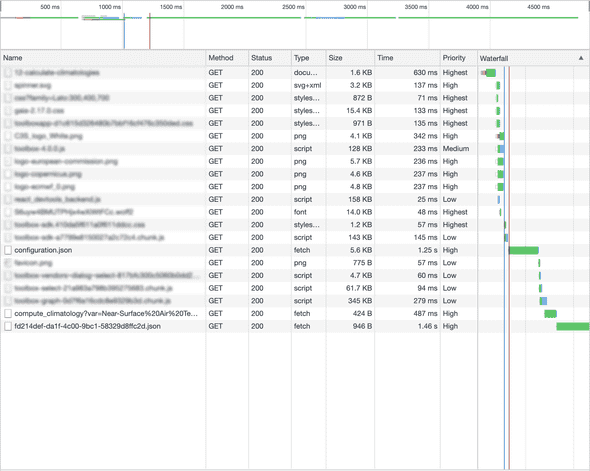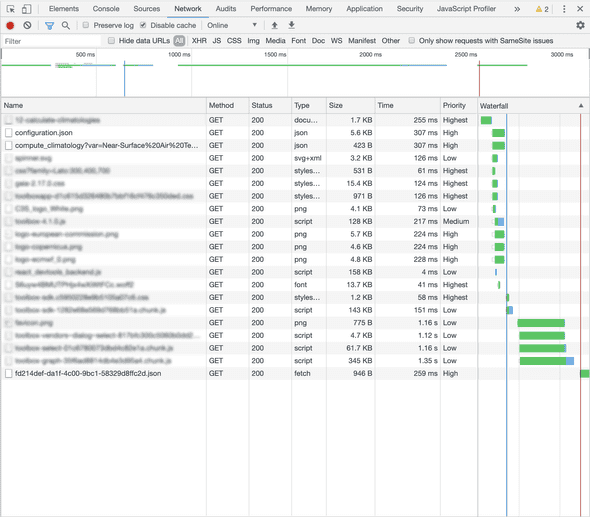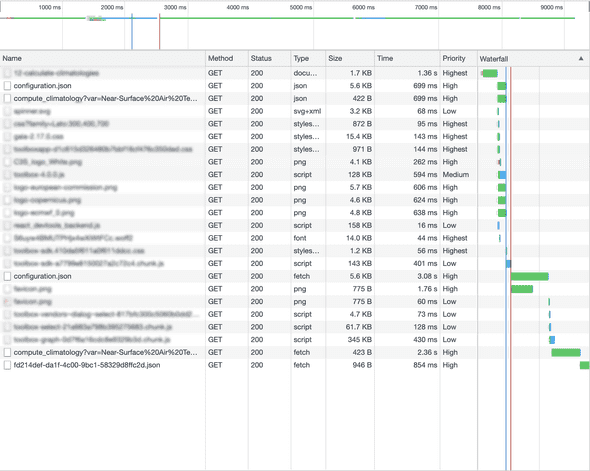A walkthrough on prioritizing resources load using link preload
March 07, 2020
What has been achieved
Last week I worked on an front-end performance optimization task for a project.
The front-end of this application (my domain) is a React application but this post has nothing to do with React.
Information here can be applied to any JavaScript application.
What I addressed is moving from a situation like this…
…to something like this…
Before focusing on the top overview timeline where it seems it goes from 4.5 sec to 2.5 sec, let me say this is not strictly true: this is a development server, response time change a lot, browser cache is disabled (because we are particularly interested on new users).
But, in any case, every test I did never gone under 1 second gain, which is a lot.
Did I refactored my JavaScript code from scratch?
Did I removed the hidden crypto-miner I hide in every project I deploy?
Did I changed my machine or network to a 10x more powerful one?
No!
I “simply” implemented a couple of resource preload using link rel="preload".
What this meant for my application? Two very important calls are not serialized anymore but performed in parallel with no side effects with other assets on the page.
I’m writing this post because this has not been exactly “easy” and I not found a single tutorial that contained all of the issues I encountered.
Now, please sorry, but to fully understand you need some small context on the application.
Few information about the service
Let me introduce some general information on the application itself.
- The JavaScript application on its own can’t do nothing interesting (as a front-end developer this make me feel useless sometimes, but I learn to live with this)
-
The application needs to download a
configuration.jsonfile -
This configuration file contains a lot of data but what it’s important for us is:
- an URL to a remote API service
- default parameters to run this remote process execution.
This remote call must be performed as soon as possible.
- Based on the configuration, the application can load additional chunks of code (some of them are pretty big and not frequently used, so it’s OK to not waste user’s bandwidth downloading them for every user)
-
The API response depends on the configuration itself and commonly contains URI to additional resources (most of the times: images or JSON files).
Downloading this final data is essential for displaying something useful to the user. In our simple example the final output is a JSON compatible with the plotly.js library.
This was the general workflow of the application, but let me highlight more:
- Until the main JavaScript code has not been loaded we display a spinner (I know, I know… no SSR yet).
- Until the
configuration.jsonhas not been loaded we can’t say anything about what to show on the screen, so we just display a loading indicator.
What I mean: React is up and running, but it has not bloody idea on what to do. -
When both the main JavaScript source and the configuration file are loaded we can both:
- start the execution (by calling the API)
- load additional chunks (if needed).
- start to display watermark for results we are expecting
- All these resources are cached in the browser (but as I said we were working for improving the first-visit journey) and in a caching HTTP reverse proxy.
- Almost all resources in the list, apart the main page which is cached for a short time, never change. Please note: effects of this caching layer is not visible in this example.
One final note: you probably already noted that the API call is performed with an HTTP GET method (with parameters as query string arguments).
The application can (and most of the times will) use a more common HTTP POST but when applicable (not for every kind of remote process) we use GET.
GET make the cache process easier in the reverse proxy; caching a POST is doable (at least in NGINX) but, in my limited experience, not so easy to be controlled/inspected.
The journey in the performance land
What can we do better?
Let recap our weak points. We have three main entities:
- The JavaScript main file
- The configuration file
- The request API call
The former version of the application was downloading and parsing bundle then fetching the configuration.json then calling the API.
But our server (a Python based API) is already aware of the JSON file itself (because it generate the configuration). So ideally we can start the configuration call earlier.
And this not ends here: as the configuration contains every information for performing the initial API call we still don’t need the JavaScript application to be up and running to perform it.
We can make those three calls concurrent.
Now let’s detail every attempt to reach this by using the powerful preload pattern.
What a preload pattern should do?
Briefly speaking: the browser try to fetch the resource at higher priority (more accurate: priority depends on the as attribute) so when your application try to fetch the resource the browser would say ”Hey! I already have this stuff!“.
Also notable: browser cache is still applied: if the preloaded resource is in the browser cache, cache is used for both preload and fetch.
Note:
linkwithrel="preload"is currently only supported by Chrome and Safari but, as you can guess, this covers 80% of the browsers out there.
This is enough for supporting it has it’s fully backward compatible.
Enabling preload
I was already aware of some of the issues I encountered, but I hoped that all could work by simply doing few changes.
Spoiler alert: most of tutorial you can find on the Web just say ”add a preload and live happy“.
Liars.
My first attempt: added what’s follow to our template file on the server (syntax should be straightforward although this is a Jinja template):
<link rel="preload" as="fetch" href="{{ configuration_url }}" />
<link rel="preload" as="fetch" href="{{ run_url }}" />Not much to say: just tried to put URIs to configuration.json (configuration_url) and API with query string (run_url) in a preload elements.
This didn’t worked. Even worst: resources are loaded twice:
Hey! Preloading operation is running… so why the browser don’t reuse the same information?
The solution can be found in the console:
A preload for '.../configuration.json' is found, but is not used because the request headers do not match.Plus another similar message for the API call.
Just Googling for this and you will find a general answer: to be reused, a preload request must have identical headers to the default request.
So this is our task now: let’s make headers identical.
Easy. Or not?
For now let’s focus on the configuration request only, for brevity.
Note: from now on: stuff inside the
<...>placeholder is omitted but is never an issue, so equals on both preload and canonical requests.
These are the headers of the preload request:
:authority: <...>
:method: GET
:path: <...>/configuration.json
:scheme: https
accept: */*
accept-encoding: gzip, deflate, br
accept-language: <...>
cache-control: no-cache
cookie: <...>
pragma: no-cache
referer: <...>
sec-fetch-dest: empty
sec-fetch-mode: no-cors
sec-fetch-site: same-origin
user-agent: <...>…and these headers sent with the JavaScript fetch:
:authority: <...>
:method: GET
:path: <...>/configuration.json
:scheme: https
accept: */*
accept-encoding: gzip, deflate, br
accept-language: <...>
cache-control: no-cache
content-type: application/json
cookie: <...>
pragma: no-cache
referer: <...>
sec-fetch-dest: empty
sec-fetch-mode: cors
sec-fetch-site: same-origin
user-agent: <...>Let focus on differences:
| preload | fetch |
|---|---|
| nothing | content-type: application/json |
sec-fetch-mode: no-cors |
sec-fetch-mode: cors |
As you can see the difference is only for the content-type and sec-fetch-mode headers. The former is not there in the preload call, while the latter change from no-cors to cors.
A similar result if obtained for the failed API call (let me only show the resume table):
| preload | fetch |
|---|---|
| nothing | content-type: application/json |
sec-fetch-mode: no-cors |
sec-fetch-mode: cors |
accept: */* |
accept: application/json |
Issue: Accept header
Let start from this last new entry: the Accept header.
It seems that every preload request is providing an accept: */* header value.
Live with that.
This is an easy fix on my side as the application/json value was explicitly addeded in the code.
Follow a pseudo-code of my fetch service (the real fetch service is a more complex service but I’m trying to be simple):
fetch(URL, method, {
credentials: "include",
"Content-Type": "application/json",
Accept: "application/json", // other call specific headers and params
})The Accept header there is not wrong at all, it was added because in ancient ages responses from the backend were not only JSON but also a YAML format was allowed.
This is not true anymore and I was able to remove the header with no issues.
fetch(URL, method, {
credentials: "include",
"Content-Type": "application/json",
// other call specific headers and params
})Note: you probably noticed that I’m performing a cross-origin requests with cookies (credentials: "include").
This is by design:
- some instances of our applications are embeddable on 3rd party pages
- few applications are public. Other only runs previous authentication
This will be important later.
Issue: Content-Type header
There’s a way to specify a content-type in a link request?
It seems not: it’s true you can add a type attribute, so what’s follow is perfectly valid:
<link
rel="preload"
as="fetch"
href="{{ configuration_url }}"
type="application/json"/>
<link rel="preload" as="fetch" href="{{ run_url }}" type="application/json" />But this is not changing the content-type in any way (still I like being explicit and I didn’t removed them).
OK, let’s try to simply make headers equals, so we can again change the fetch:
fetch(URL, method, {
credentials: "include",
// other call specific headers and params
})So we are not sending any special headers now (but this is wrong… continue reading).
Issue: sec-fetch-mode header
Finally something we can’t fix from JavaScript.
The sec-fetch-mode header (as any other header starting with sec-*) is a forbidden header name so we can’t manipulate it from JavaScript, for security reasons.
The browser is automatically setting it to cors because of the credentials fetch setting.
How can we fix this?
preload with crossorigin
Cross-origin calls are everywhere and luckily the preload specs supports them: you can make a preload request cross-origin by providing the crossorigin attribute.
The crossorigin attribute is common for loading remote fonts.
Available options here are:
- the default
anonymousvalue use-credentials.
Let say I put use-credentials (I also tried with anonymous if you want to know) so we have:
<link
rel="preload"
as="fetch"
href="{{ configuration_url }}"
type="application/json"
crossorigin="use-credentials"/>
<link
rel="preload"
as="fetch"
href="{{ run_url }}"
type="application/json"
crossorigin="use-credentials"/>Did this fix my headers issue?
We fixed the sec-fetch-mode so playing with the crossorigin was OK.
Generally speaking: we need to make both crossorigin settings (using crossorigin in preload and credentials in fetch) compatible to each other.
Also, a new Origin header has been added automatically, but this header is equal on both requests so didn’t introduced new issues.
The Origin header
Even if the Origin header don’t start with sec- it’s still a forbidden header name.
This is obvious, a lot of security is based on this header and we can’t make it editable from JavaScript.
Lesson learned: every time we have a cross-origin request, the browser automatically set the Origin head.
Moving away from cross-origin requests
I could have stopped here, but I was not fully happy (that’s the sad story of my life).
My original attempt was to make both sec-fetch-mode values equals to cors, but there’s something to reflect upon.
As I said earlier the application is, by design, developed to perform cross-origin request, but in every case where I care about preloading I am in a same-origin case.
Even better: I’m particularly interested on boosting performance of public application, where there’s not authentication at all.
Generally speaking: I like the idea to have the most restrictive and secure configuration: if you need few permissions I want to give you only the minimal set.
You probably guessed what I mean: can we get rid of cross-origin calls?
To address this let’s go back to the old version of my preload links:
<link
rel="preload"
as="fetch"
href="{{ configuration_url }}"
type="application/json"
/>
<link rel="preload" as="fetch" href="{{ run_url }}" type="application/json" />Now I need to do the other way around in my fetch too by disabling CORS completely:
fetch(URL, method, {
mode: "no-cors", // other call specific headers and params
})(note this is still a pseudo-code… I still need CORS in every not-same-domain environment)
So this simple change worked? It was so easy?
These are the “final” complete headers list:
:authority: <...>
:method: GET
:path: <...>/configuration.json
:scheme: https
accept: */*
accept-encoding: gzip, deflate, br
accept-language: <...>
cache-control: no-cache
cookie: <...>
pragma: no-cache
referer: <...>
sec-fetch-dest: empty
sec-fetch-mode: no-cors
sec-fetch-site: same-origin
user-agent: <...>…but.
I was congratulating myself for being a smart guy and for this heroic spelunking into the preload world when a coworker pinged me on Slack saying:
“Hey, an application I was working on is not working anymore”
After some time spent debugging server side issues and pointing my finger on my colleague (because hey, if you get a 500 status the problem is from the backend-developer, right?) we found that the server was not receiving parameters anymore for every application that was using POST instead of GET. GET was OK.
I was able to reproduce easily in my test application too by changing the submit method to POST (GET or POST is another configuration.json settings).
Follows headers sent with the request that get an HTTP 500 error:
:authority: <...>
:method: POST
:path: <...>/compute_climatology
:scheme: https
accept: */*
accept-encoding: gzip, deflate, br
accept-language: <...>
cache-control: no-cache
content-length: 64
content-type: text/plain;charset=UTF-8cookie: <...>
origin: <...>
pragma: no-cache
referer: <...>
sec-fetch-dest: empty
sec-fetch-mode: no-cors
sec-fetch-site: same-origin
user-agent: <...>If you look at the header list above you can see there’s a Content-Type as text/plain;charset=UTF-8.
Let me say I’m not setting this header anywhere in my code.
And to be honest our API server is right: I’m POSTing a JSON encoded form and it needs to be informed about this; “making it work” on the server by allowing a text/plain input is bad for any API design.
Removing the Content-Type for all type of requests was a mistake but providing it for a simple GET request is an error too!
How can a GET request be in JSON format?
So my code was not formally correct from the beginning.
So let’s fix this by restoring my Content-Type header just for POST, something like this:
fetch(URL, method, {
mode: "no-cors",
...(method !== 'GET" && { Content-Type": "application/json" }), // other call specific headers and params
})This seems OK but changed nothing: the browser is overriding any value to text/plain;charset=UTF-8.
What’s going on?
Thanks to some StackOverflow answer I found an explanation in the Request.mode page.
In case value is no-cors it says:
Prevents the method from being anything other than HEAD, GET or POST, and the headers from being anything other than simple headers
Roughly speaking: if I use no-cors I have this Content-Type: text/plain automatically set and no override is possible.
But the solution in my case is quite easy because I need no-cors only for same-site GET requests!
So let’s now present the “final” version of the pseudo-code:
fetch(URL, method, {
credentials: 'same-site',
...(method === 'GET' && { mode: 'no-cors' }), ...(method !== 'GET" && { Content-Type": "application/json" }), // other call specific headers and params
})Now applications are working properly with GET and POST requests and, when using GET, preload is up and running.
Push performance, more and more
Let’s conclude this post with some final notes about possible future improvements and other patterns.
Embedding configuration.json in the HTML
Somewhere at the top I said that our Python server knows the content of the configuration file.
So why not embedding it in the HTML instead of:
- writing an URL to the HTML
- making the JavaScript download it
Good point.
Let me say we use HTTP2. Now, HTTP2 is not a silver bullet, but the cost of downloading an additional resource is low.
OK, “low” is not “none”, but having a separate resource brings another big advantage: it can be cached, in this case, forever.
Also this strong caching is not only for what we call “public apps”, but for every kind of application, so also an authenticated user gains some benefit.
HTTP2 push
Another approach is HTTP2 push, which is powerful and can be directly used from NGINX by providing a LINK header from the upstream server.
But the cache issue remains: pushing a resource from the server every time means no caching or we need a way to know if the client has the resource in the cache… Way too complex.
Move along, move along.







